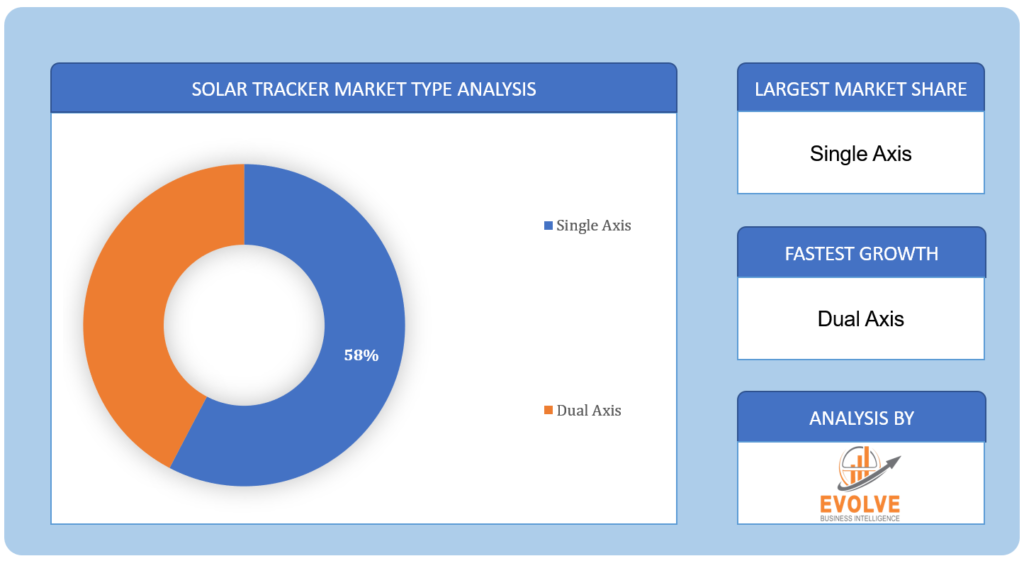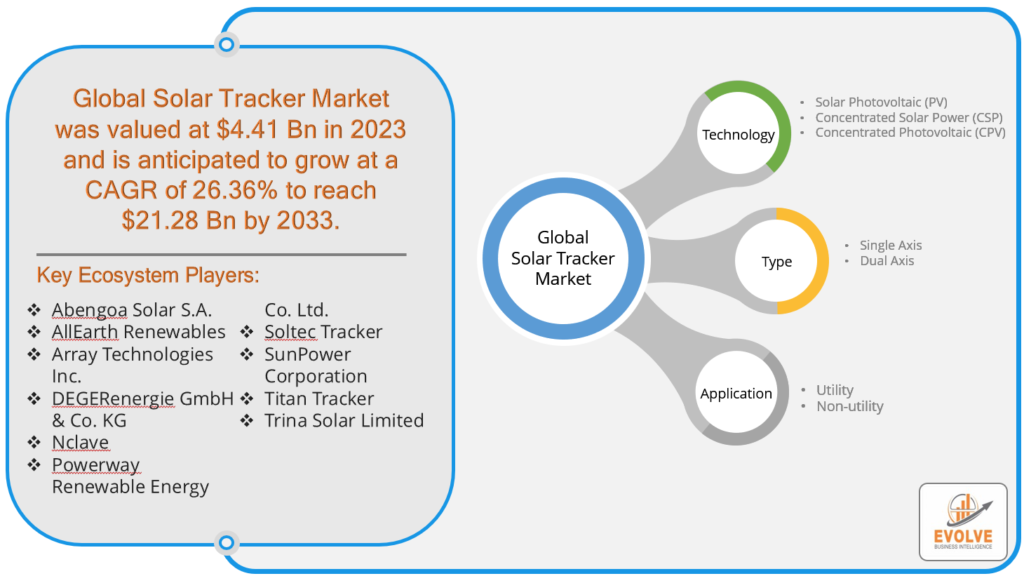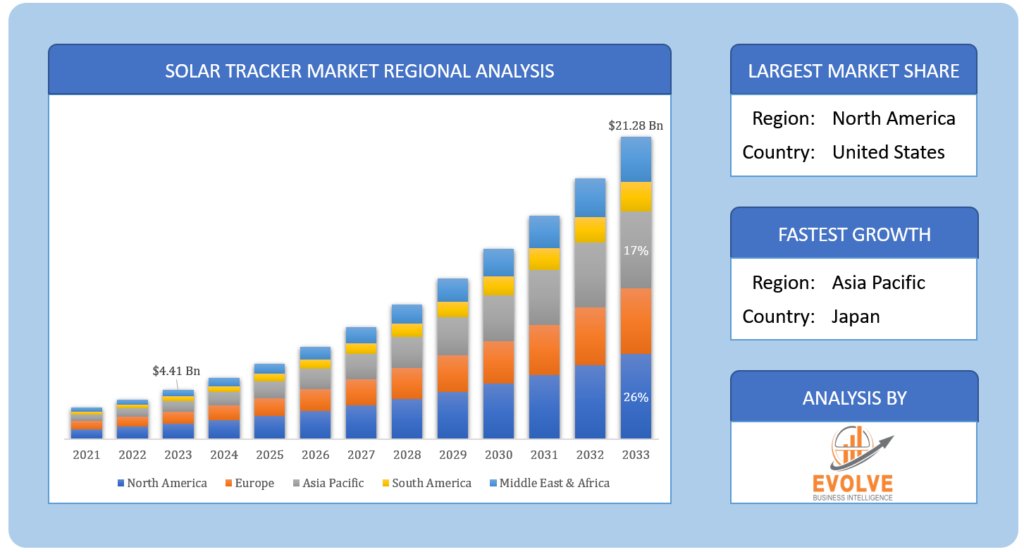Solar Tracker Market Overview
The Solar Tracker Market Size is expected to reach USD 21.28 Billion by 2033. The Solar Tracker industry size accounted for USD 4.41 Billion in 2023 and is expected to expand at a CAGR of 26.36% from 2023 to 2033. A solar tracker is a sophisticated electromechanical or electronic system used in solar energy systems to autonomously orient solar panels or solar collectors in real time, optimizing their alignment with the sun’s trajectory throughout the day. By continuously adjusting the positioning of solar components to maximize their exposure to sunlight, solar trackers enhance energy capture and overall energy output in photovoltaic (PV) and concentrating solar power (CSP) applications. This technology involves precise sensor and actuator mechanisms to ensure that solar panels or mirrors remain perpendicular to the sun’s rays, increasing the efficiency and productivity of solar energy installations. Solar trackers can be categorized into single-axis and dual-axis systems, each designed to track the sun’s movements to varying degrees of complexity and cost.
Global Solar Tracker Market Synopsis
The Solar Tracker market experienced a moderate impact from the COVID-19 pandemic. The global solar industry faced disruptions in supply chains, manufacturing, and construction due to lockdowns and restrictions, leading to project delays and logistical challenges. However, the impact was relatively moderate when compared to some other sectors, as the solar energy sector demonstrated resilience. The pandemic underscored the importance of sustainable and resilient energy sources, driving increased interest in renewable energy solutions. Government incentives and policies aimed at promoting clean energy also played a role in sustaining demand for solar trackers, leading to a recovery in the market over time as the industry adapted to the new operational norms and heightened focus on environmental considerations.
Global Solar Tracker Market Dynamics
The major factors that have impacted the growth of Solar Tracker are as follows:
Drivers:
⮚ Growing Adoption of Renewable Energy
The increasing global focus on reducing greenhouse gas emissions and transitioning to sustainable energy sources is a significant driver for the Solar Tracker market. Solar trackers enhance the efficiency of solar energy systems, making them more attractive and cost-effective, especially in regions with abundant sunlight. Government policies and incentives promoting renewable energy further accelerate the adoption of solar trackers in utility-scale solar projects.
Restraint:
⮚ High Initial Investment Costs
The Solar Tracker market is the high initial capital cost associated with these systems. Solar tracker technology can add a substantial expense to solar projects, which can deter potential investors and project developers. However, over time, this cost can be offset by increased energy production and efficiency, making it an attractive long-term investment.
Opportunity:
⮚ Technological Advancements
The ongoing advancements in solar tracker technology offer a significant opportunity for the market. Innovations such as improved tracking algorithms, more durable materials, and enhanced control systems are increasing the overall performance and reliability of solar trackers. These advancements can lead to reduced maintenance costs and increased energy generation, making solar trackers more attractive to a wider range of applications and potential customers, including residential and commercial solar installations.
Solar Tracker Market Segment Overview
By Technology
Based on Technology, the market has been divided into Solar Photovoltaic (PV), Concentrated Solar Power (CSP), and Concentrated Photovoltaic (CPV). The Solar Photovoltaic (PV) segment is expected to hold the largest market share in the Solar Tracker market due to the increasing demand for efficient electricity generation from solar panels, especially in utility-scale and commercial solar projects.
By Type
 Based on the Type, the market is segmented based on Single Axis and dual Axis. The Single Axis segment was projected to hold the largest market share in the Solar Tracker market due to its cost-effectiveness and widespread adoption in utility-scale solar projects, offering improved energy efficiency.
Based on the Type, the market is segmented based on Single Axis and dual Axis. The Single Axis segment was projected to hold the largest market share in the Solar Tracker market due to its cost-effectiveness and widespread adoption in utility-scale solar projects, offering improved energy efficiency.
By Application
Based on the Application, the market has been divided into Utility and non-utility. The Utility segment is expected to hold the largest market share in the Elbow Sleeve market due to the high demand for these products in sports and athletic applications, injury prevention, and therapeutic use.
Global Solar Tracker Market Regional Analysis
Based on region, the market has been divided into North America, Europe, Asia-Pacific, the Middle East & Africa, and Latin America. The area of North America is anticipated to dominate the market for the usage of Solar Tracker, followed by those in Asia-Pacific and Europe.
 North America Market
North America Market
North America has asserted significant dominance in the Solar Tracker market, driven by a combination of factors. The region benefits from a robust solar energy industry with a strong focus on renewable energy adoption. The United States, in particular, has experienced substantial growth in solar installations, supported by government incentives, renewable energy goals, and a proactive approach to sustainable energy solutions. The presence of large utility-scale solar projects across the continent, coupled with favorable regulatory policies and a well-developed infrastructure, has propelled North America to the forefront of the Solar Tracker market. Moreover, advancements in solar tracking technology have played a pivotal role in improving the efficiency and cost-effectiveness of solar energy production, further cementing North America’s position as a key player in the global solar tracking industry.
Asia Pacific Market
The Asia-Pacific region has been experiencing remarkable growth in the Solar Tracker market, driven by several compelling factors. The increasing energy demand, coupled with a growing awareness of environmental sustainability, has led many countries in the region to invest significantly in renewable energy sources. Governments across Asia-Pacific have implemented favorable policies and incentives to promote solar power adoption, spurring a surge in solar tracker installations, especially in countries like China and India. The abundant availability of sunlight in this region, combined with the need for reliable and sustainable energy, has made solar trackers a pivotal component of large-scale solar projects, contributing to their impressive growth and further establishing the Asia-Pacific region as a key player in the global solar tracker market.
Competitive Landscape
The competitive landscape includes key players (tier 1, tier 2, and local) having a presence across the globe. Companies such as Abengoa Solar S.A., AllEarth Renewables, Array Technologies Inc., DEGERenergie GmbH & Co. KG, and Nclave are some of the leading players in the global Solar Tracker Industry. These players have adopted partnership, acquisition, expansion, and new product development, among others as their key strategies.
Key Market Players:
● AllEarth Renewables
● Array Technologies Inc.
● DEGERenergie GmbH & Co. KG
● Nclave
● Powerway Renewable Energy Co. Ltd.
● Soltec Tracker
● SunPower Corporation
● Titan Tracker
● Trina Solar Limited
Key development:
In February 2023, PV Hardware (PVH), a prominent solar PV tracker manufacturer under Spain’s Gransolar Group, unveiled plans to construct the world’s largest solar tracker factory in Valencia, Spain. This facility aims to significantly enhance its annual global production and supply capacity, reaching a total of 25 GW.
In October 2022, Gonvarri Solar Steel announced a substantial agreement to provide approximately 1.2 GW worth of solar trackers and rack solutions for numerous solar projects in the Iberian Peninsula. Iberdrola SA, as part of this deal, placed an order for 289 MW of Gonvarri Solar Steel’s TracSmarT+ 1V single and double row trackers, along with 938 MW of their RackSmarT fixed structures.
Scope of the Report
Global Solar Tracker Market, by Technology
● Solar Photovoltaic (PV)
● Concentrated Solar Power (CSP)
● Concentrated Photovoltaic (CPV)
Global Solar Tracker Market, by Type
● Single Axis
● Dual Axis
Global Solar Tracker Market, by Application
● Utility
● Non-utility
Global Solar Tracker Market, by Region
● North America
– US
– Canada
– Mexico
● Europe
– UK
– Germany
– France
– Italy
– Spain
– Benelux
– Nordic
– Rest of Europe
● Asia Pacific
– China
– Japan
– South Korea
– Indonesia
– Austalia
– Malaysia
– India
– Rest of Asia Pacific
● South America
– Brazil
– Argentina
– Rest of South America
● Middle East & Africa
– Saudi Arabia
– UAE
– Egypt
– South Africa
– Rest of Middle East & Africa
REPORT CONTENT BRIEF:
● High-level analysis of the current and future Solar Tracker Industry trends and opportunities
● Detailed analysis of current market drivers, restraining factors, and opportunities analysis in the future
● Historical market size for the year 2021, and forecast from 2023 to 2033
● Solar Tracker market share analysis for each segment
● Competitor analysis with a comprehensive insight into its product segment, financial strength, and strategies adopted.
● Identifies key strategies adopted by the key players including new product development, mergers and acquisitions, joint ventures, collaborations, and partnerships.
● To identify and understand the various factors involved in the global Solar Tracker market affected by the pandemic
● To provide year-on-year growth from 2022 to 2033
● To provide short-term, long-term, and overall CAGR comparison from 2022 to 2033.
● Provide Total Addressable Market (TAM) for the Global Solar Tracker Market.












